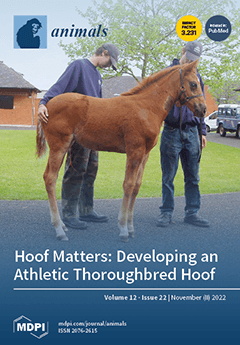This trial evaluated how dietary-accommodated pomelo peel powder (PPP) affected average daily feed intake (ADFI) and average daily gain (ADG), diarrhea, antioxidation, and colonic microbial in weaned piglets. Thirty piglets weaned at 28 d were divided into three groups: a basal diet (CON); a CON containing 75 mg/kg chlortetracycline (CTC); and a CON containing 8 g/kg (PPP). This trial had a period of 28 days. Piglets supplemented with PPP had higher ADFI and ADG than piglets in CTC and CON (
p < 0.05). The diarrhea rate in PPP and CTC was lower than in CON in the 3rd and 4th weeks (
p < 0.05). Serum superoxide dismutase and glutathione peroxidase enzyme activities, and total antioxidant capacity in PPP were higher than those in CON (
p < 0.05). Serum interleukin (IL)-4, insulin-like growth factor-I, immunoglobulin (Ig)A, and IgG concentrations in the PPP and CTC groups were higher than those in the CON group (
p < 0.05). Serum IL-1β, IL-8, IL-17, and interferon (IFN)-γ concentrations and the cecal pH in PPP were lower than those in CON (
p < 0.05). Serum IL-1β, IFN-γ, and IgA concentrations of piglets in PPP were lower than in CTC (
p < 0.05). The villus height and villus height/crypt depth of the ileum of piglets in PPP and CTC were higher than those in CON (
p < 0.05), but there was no difference between PPP and CTC (
p > 0.05). The Firmicutes and Cyanobacteria relative abundances in PPP and CTC (
p < 0.05) were lower than those in CON, whereas the Bacteroidetes relative abundances in PPP and CTC were higher than those in CON. The Prevotellaceae relative abundance in CTC was higher than in CON (
p < 0.05), whereas the Lactobacillaceae relative abundance in CTC was lower than in CON (
p < 0.05). The Ruminococcaceae relative abundance in PPP was higher than in CON (
p < 0.05), whereas the Veillonellaceae relative abundance in PPP was lower than in CON (
p < 0.05). PPP can improve ADFI and ADG, relieve diarrhea, and enhance the colonic microflora of weaned piglets. Therefore, PPP is expected to replace CTC as a feed additive to alleviate weaning stress and ensure normal growth and development of piglets.
Full article






